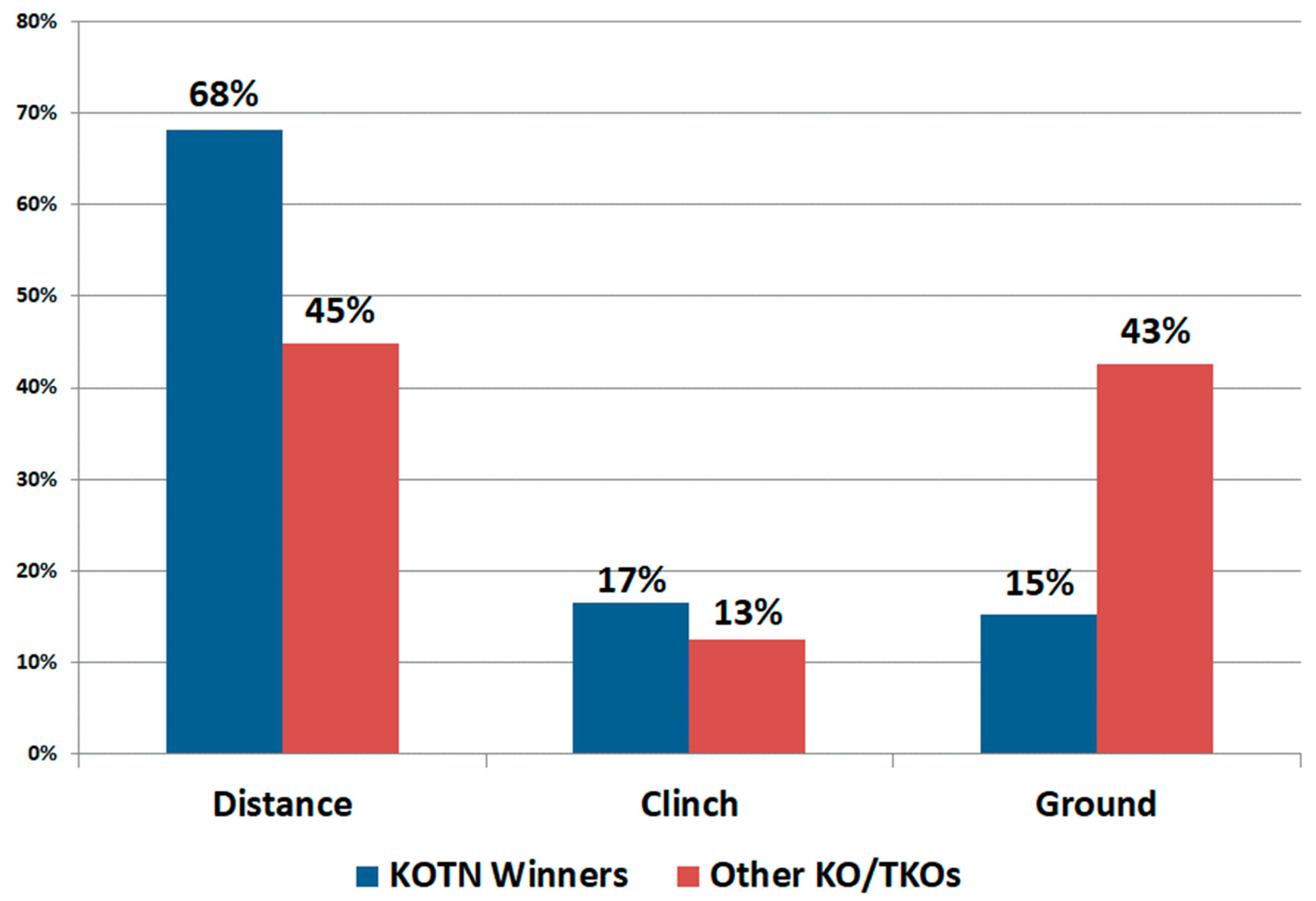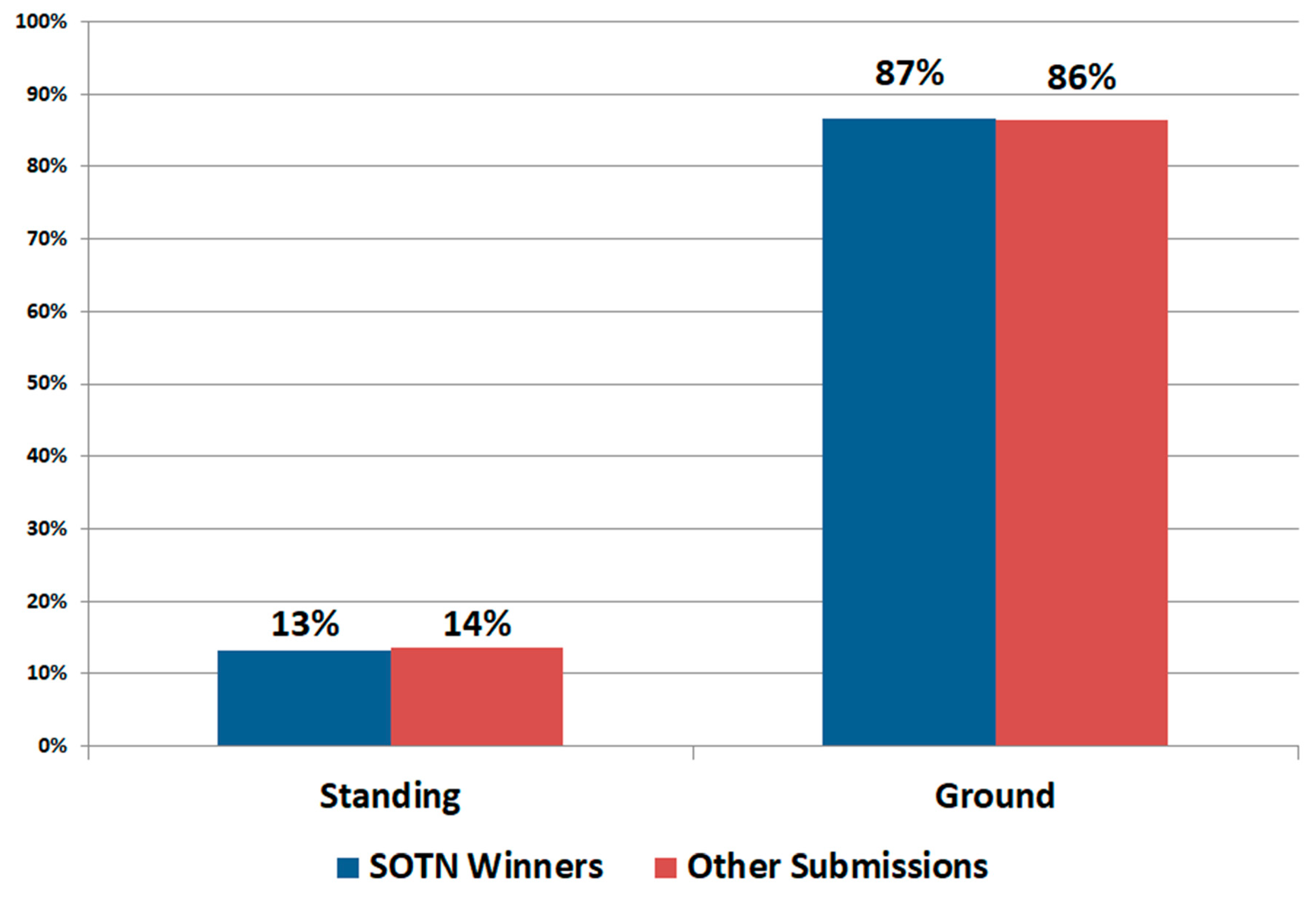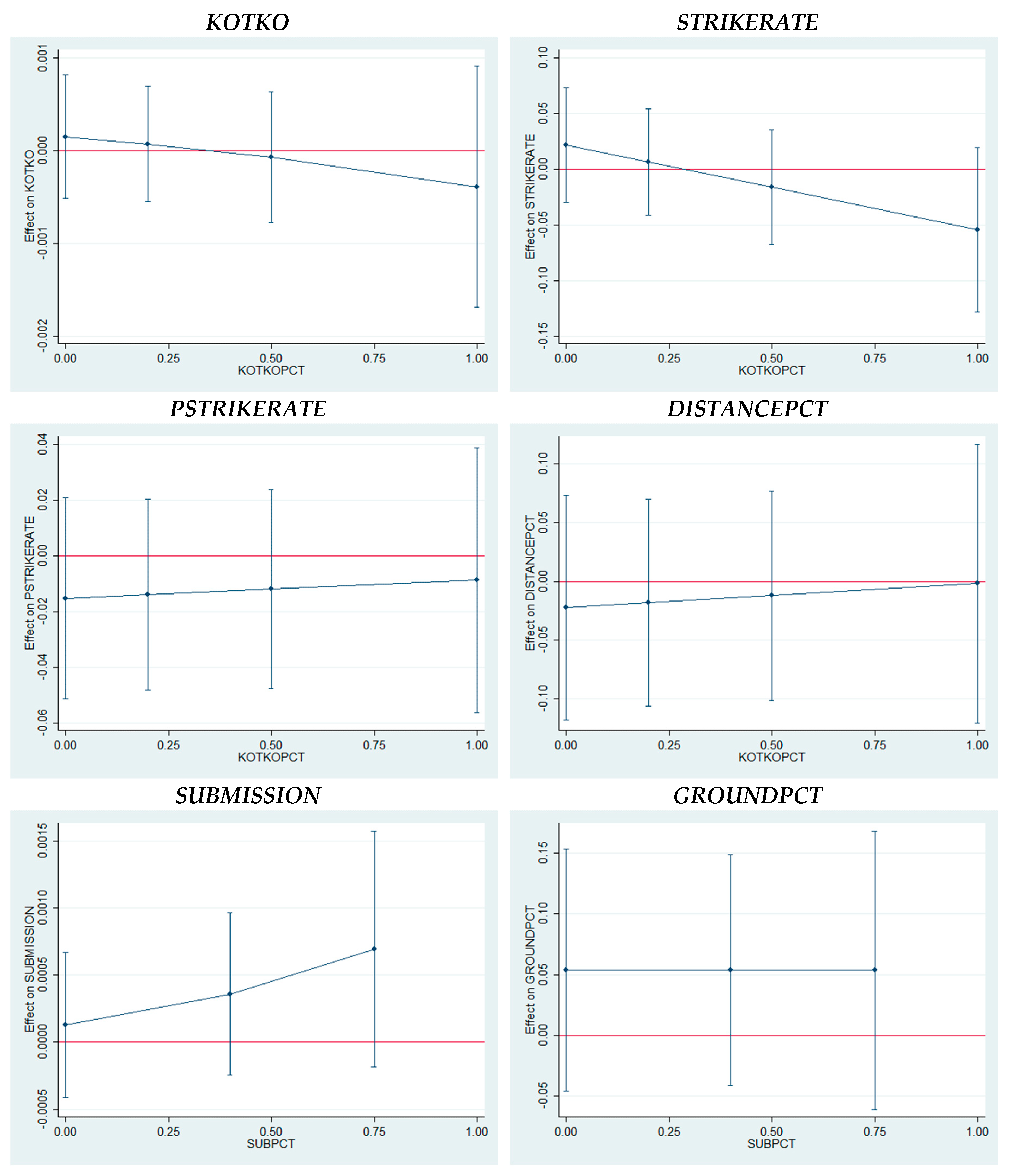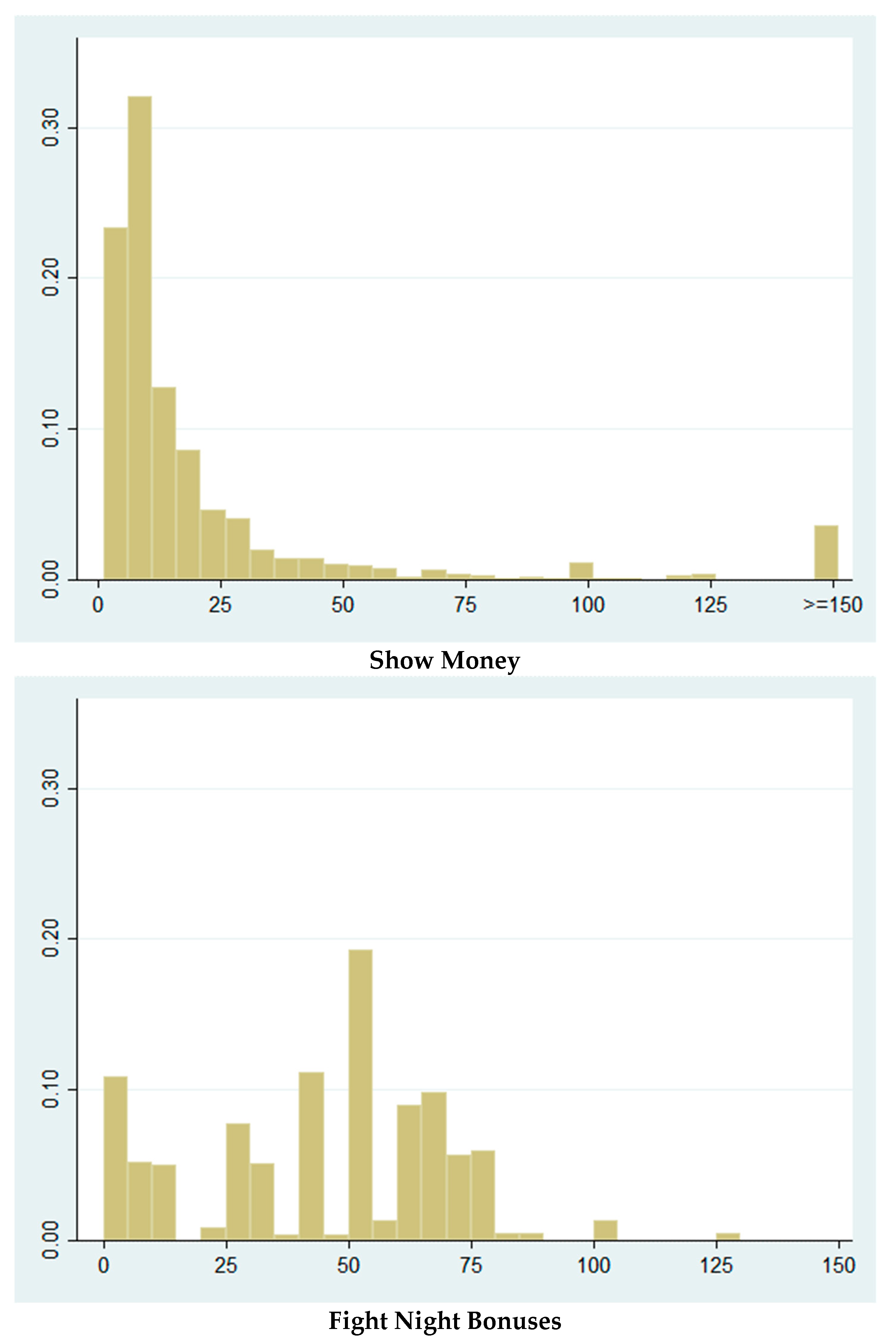Performance Bonuses and Effort: Evidence from Fight Night Awards in Mixed Martial Arts
Abstract
:1. Introduction
2. MMA/UFC Background
3. Data
3.1. FightMetric LLC
3.2. Descriptive Statistics
4. Model
5. Empirical Results
6. Discussion
7. Conclusions
Acknowledgments
Conflicts of Interest
References
- Becker, Brian, and Mark Huselid. 1992. The incentive effects of tournament compensation systems. Administrative Science Quarterly 37: 336–50. [Google Scholar] [CrossRef]
- Berri, David, Michael Leeds, and Peter von Allmen. 2015. Salary determination in the presence of fixed revenues. International Journal of Sport Finance 10: 5–25. [Google Scholar]
- Bieler, Des. 2016. New York Becomes Final State to Legalize MMA Events. Washingtonpost.com. Available online: https://www.washingtonpost.com/news/early-lead/wp/2016/03/22/new-york-becomes-final-state-to-legalize-mma-events (accessed on 12 February 2018).
- Bleichrodt, Han, Olivier L’Haridon, and David Van Ass. 2018. The risk attitudes of professional athletes: Optimism and success are related. Decision 5: 95–118. [Google Scholar] [CrossRef]
- Collier, Trevor, Andrew L. Johnson, and John Ruggiero. 2012. Aggression in mixed martial arts: An analysis of the likelihood of winning a decision. In Violence and Aggression in Sporting Contests: Economics, History, and Policy. Edited by R. Todd Jewell. New York: Springer, pp. 97–109. [Google Scholar]
- Ehrenberg, Ronald, and Michael Bognanno. 1990a. Do tournaments have incentive effects? Journal of Political Economy 98: 1307–24. [Google Scholar] [CrossRef]
- Ehrenberg, Ronald, and Michael Bognanno. 1990b. The incentive effects of tournaments revisited: Evidence from the European PGA tour. Industrial & Labor Relations Review 43: 74S–88S. [Google Scholar]
- Erickson, Matt. 2013. Dana White Makes It Official: UFC Fight-Night Bonuses Staying. Mmajunkie.com. Available online: https://mmajunkie.com/2013/07/dana-white-makes-it-official-ufc-fight-night-bonuses-staying (accessed on 12 May 2018).
- Genauer, Rami. 2013. Interviewed by Paul Gift, Los Angeles, CA, January. [Google Scholar]
- Gift, Paul. 2018. Moving the Needle in MMA: On the Marginal Revenue Product of UFC Fighters. Manuscript submitted for publication. [Google Scholar]
- Kahneman, Daniel, and Amos Tversky. 1982. The psychology of preferences. Scientific American 246: 160–73. [Google Scholar] [CrossRef]
- Lazear, Edward, and Paul Oyer. 2012. Personnel economics. In The Handbook of Organizational Economics. Edited by Robert Gibbons and John Roberts. Princeton: Princeton University Press, pp. 479–519. [Google Scholar]
- Le, Cung, Nathan Quarry, Jon Fitch, Brandon Vera, Luis Javier Vazquez, Kyle Kingsbury, and Zuffa, LLC. 2018. Case No. 2:15-cv-01045-RFB-PAL. Zuffa, LLC’s Opposition to Plaintiffs’ Motion for Class Certification. ECF No. 540, Exhibit 92 (D. Nev. April 6, 2018) . [Google Scholar]
- Lynch, James, and Jeffrey Zax. 2000. The rewards to running. Journal of Sports Economics 1: 323–40. [Google Scholar] [CrossRef]
- Maloney, Michael, and Robert McCormick. 2000. The response of workers to wages in tournaments: Evidence from foot races. Journal of Sports Economics 1: 99–123. [Google Scholar] [CrossRef]
- Marrocco, Steven. 2013. Bryan Caraway Haggles for Bigger Fight-Night Bonuses at UFC 159. Mmajunkie.com. Available online: http://mmajunkie.com/2013/04/bryan-caraway-haggles-for-bigger-fight-night-bonuses-at-ufc-159 (accessed on 15 May 2018).
- McCann, Michael. 2006. It’s not about the money: The role of preferences, cognitive biases and heuristics among professional athletes. Brooklyn Law Review 71: 1459–528. [Google Scholar]
- MMA Junkie Staff. 2013. All UFC Fight-Night Bonuses Now Capped at $50,000. Mmajunkie.com. Available online: http://mmajunkie.com/2013/03/all-ufc-fight-night-bonuses-now-capped-at-50000 (accessed on 15 May 2018).
- Reams, Lamar, and Stephen Shapiro. 2017. Who’s the main attraction? Star power as a determinant of Ultimate Fighting Championship pay-per-view demand. European Sport Management Quarterly 17: 132–51. [Google Scholar] [CrossRef]
- Sauer, Raymond D. 2005. The state of research on markets for sports betting and suggested future directions. Journal of Economics and Finance 29: 416–26. [Google Scholar] [CrossRef]
- Snowden, Jonathan. 2013. The Business of Fighting: A Look inside the UFC’s Top-Secret Fighter Contract. Bleacherreport.com. Available online: https://bleacherreport.com/articles/1516575-the-business-of-fighting-a-look-inside-the-ufcs-top-secret-fighter-contract (accessed on 15 May 2018).
- Tainsky, Scott, Steven Salaga, and Carla Almeida Santos. 2012. Estimating attendance for the Ultimate Fighting Championship: A demand theory approach. International Journal of Sport Management and Marketing 11: 206–24. [Google Scholar] [CrossRef]
- Tainsky, Scott, Steven Salaga, and Carla Almeida Santos. 2013. Determinants of pay-per-view broadcast viewership in sports: The case of the Ultimate Fighting Championship. Journal of Sport Management 27: 43–58. [Google Scholar] [CrossRef]
- Tenorio, Rafael. 2000. The economics of professional boxing contracts. Journal of Sports Economics 1: 363–84. [Google Scholar] [CrossRef]
- UFC. 2014. UFC Statement on Fight Night Bonuses. Ufc.com. Available online: http://www.ufc.com/news/UFC-Statement-on-Fight-Night-Bonuses (accessed on 19 May 2018).
- UFC. 2019. About UFC. Ufc.com. Available online: https://www.ufc.com/about (accessed on 9 January 2019).
- U.S. House of Representatives Committee on Energy and Commerce. 2017. Perspectives on Mixed Martial Arts: Background Memo. House.gov. Available online: https://docs.house.gov/meetings/IF/IF17/20171109/106604/HHRG-115-IF17-20171109-SD003.pdf (accessed on 15 December 2017).
- Watanabe, Nicholas. 2012. Demand for pay-per-view consumption of Ultimate Fighting Championship events. International Journal of Sport Management and Marketing 11: 225–38. [Google Scholar] [CrossRef]
- Watanabe, Nicholas. 2015. Sources of direct demand: An examination of demand for the Ultimate Fighting Championship. International Journal of Sport Finance 10: 26–41. [Google Scholar]
| 1 | FightMetric does not separately record whether a fight ended by knockout (KO) or technical knockout (TKO), so they will collectively be referred to as KO/TKO for the remainder of the paper. |
| 2 | There were only two fouls at UFC 1: Eye gouging and biting. By 2017, there were 26 fouls under the Unified Rules of MMA. |
| 3 | In the U.S., MMA is now legal in all 50 states following New York’s legalization of the sport in 2016 (Bieler 2016). |
| 4 | There were four exceptions to the UFC’s standardized bonus policy through the end of the sample period in February 2014 resulting in bonuses of $60,000 (twice), $65,000, and $75,000. In one case, a fighter reportedly convinced UFC President Dana White to increase the bonus to $65,000 during the pre-fight meeting, which suggests fighters are cognizant of bonus sizes leading up to an event (Marrocco 2013). |
| 5 | Weigh-ins took place one day prior to each event. |
| 6 | FightMetric is the official statistics provider of the UFC. |
| 7 | Fighters are “at distance” when they are standing but separated, “in the clinch” when they are standing and touching each other, and “on the ground” when at least one of them is not standing. |
| 8 | The promotion’s sole PPV event, WEC 48, had bonus awards of $65,000. |
| 9 | For example, Pat Barry won $120,000 in bonuses (KOTN and FOTN) at UFC 104 while his contracted show and win money were $7000 each. |
| 10 | In December 2012, Bellator’s former lightweight champion, Eddie Alvarez, signed with the UFC. Bellator exercised its right of first refusal and sued Alvarez to enforce its contractual matching rights. |





| Variable Label | Description |
|---|---|
| Dependent | |
| FINISH | Indicator variable equal to one if a fighter won by KO/TKO or submission, and zero otherwise. |
| KOTKO | Indicator variable equal to one if a fighter won by KO/TKO, and zero otherwise. |
| SUBMISSION | Indicator variable equal to one if a fighter won by submission, and zero otherwise. |
| STRIKERATE | Total strikes attempted per five minutes. |
| PSTRIKERATE | Total power strikes attempted per five minutes. FightMetric uses various cues such as whether a strike is a kick, knee, elbow, or punch, how the strike is thrown, the effect on the opponent, etc. to determine if a strike has power. |
| DISTANCEPCT | Percent of total fight time a fighter is standing and not touching the opponent (0–100 scale). |
| GROUNDPCT | Percent of total fight time a fighter is on the ground (0–100 scale). |
| Independent | |
| BONUS | Monetary amount of any FOTN, KOTN, or SOTN awards for each event (in thousands). |
| REALBONUS | Inflation-adjusted BONUS using the Consumer Price Index. |
| AGE | Age (in years). |
| HEIGHT | Height (in inches). |
| REACH | Reach (in inches). |
| LEFTVSRIGHT | Indicator variable equal to one if a fighter is left-handed (i.e., a southpaw) fighting against a right-handed opponent, and zero otherwise. |
| EXPER | The number of Zuffa bouts a fighter has in the FightMetric database. |
| SNPROB | Standard normalization win probability of Sauer (2005). |
| MAINEVENT | Indicator variable equal to one if the bout headlined the event, and zero otherwise. |
| 5ROUNDS | Indicator variable equal to one if the bout was scheduled for five rounds, and zero otherwise. |
| TITLE | Indicator variable equal to one if the bout was a title fight, and zero otherwise. |
| PPV | Indicator variable equal to one if the bout took place on a PPV event, and zero otherwise. |
| KOTKOPCT | A fighter’s prior percentage of wins by KO/TKO. |
| SUBPCT | A fighter’s prior percentage of wins by submission. |
| WEIGHT | Weight class. Used for fixed effects. |
| UFC | WEC | Total | ||||
|---|---|---|---|---|---|---|
| All Events | ||||||
| Events | 227 | 29 | 256 | |||
| Bouts | 2315 | 274 | 2589 | |||
| Fighter-Bouts | 4630 | 548 | 5178 | |||
| Events with Bonus Awards | ||||||
| Events | 192 | 29 | 221 | |||
| Bouts | 2035 | 274 | 2309 | |||
| Fighter-Bouts | 4070 | 548 | 4618 | |||
| FOTN Awards per Event with Bonus | ||||||
| Zero | 3 | 2% | 1 | 3% | 4 | 2% |
| One | 180 | 94% | 25 | 86% | 205 | 93% |
| Two | 8 | 4% | 3 | 10% | 11 | 5% |
| Three | 1 | 1% | 0 | 0% | 1 | 0% |
| Total | 192 | 100% | 29 | 100% | 221 | 100% |
| KOTN Awards per Event with Bonus | ||||||
| Zero | 8 | 4% | 1 | 3% | 9 | 4% |
| One | 176 | 92% | 28 | 97% | 204 | 92% |
| Two | 7 | 4% | 0 | 0% | 7 | 3% |
| Three | 1 | 1% | 0 | 0% | 1 | 0% |
| Total | 192 | 100% | 29 | 100% | 221 | 100% |
| SOTN Awards per Event with Bonus | ||||||
| Zero | 19 | 10% | 2 | 7% | 21 | 10% |
| One | 166 | 86% | 27 | 93% | 193 | 87% |
| Two | 7 | 4% | 0 | 0% | 7 | 3% |
| Total | 192 | 100% | 29 | 100% | 221 | 100% |
| Variables | Mean | S.D. | N | Min | Max |
|---|---|---|---|---|---|
| Dependent | |||||
| FINISH | 0.29 | 0.45 | 5178 | 0 | 1 |
| KOTKO | 0.17 | 0.38 | 5178 | 0 | 1 |
| SUBMISSION | 0.11 | 0.32 | 5178 | 0 | 1 |
| STRIKERATE | 44.92 | 22.07 | 5178 | 0.0 | 416.7 |
| PSTRIKERATE | 22.01 | 13.52 | 5178 | 0.0 | 416.7 |
| DISTANCEPCT | 45.84 | 27.69 | 5178 | 1.0 | 100.0 |
| GROUNDPCT | 37.90 | 26.94 | 5178 | 0.0 | 97.2 |
| Independent | |||||
| BONUS | 42.35 | 25.20 | 5178 | 0 | 129 |
| REALBONUS | 45.09 | 26.58 | 5178 | 0 | 136 |
| AGE | 29.17 | 3.99 | 5120 | 18.5 | 47.9 |
| HEIGHT | 70.80 | 3.16 | 5174 | 61.0 | 83.0 |
| REACH | 72.71 | 3.65 | 4443 | 62.0 | 84.5 |
| LEFTVSRIGHT | 0.15 | 0.36 | 5062 | 0 | 1 |
| EXPER | 5.39 | 4.45 | 5178 | 1 | 24 |
| SNPROB | 50.00 | 18.88 | 4912 | 7.0 | 93.0 |
| MAINEVENT | 0.10 | 0.30 | 5178 | 0 | 1 |
| 5ROUNDS | 0.08 | 0.27 | 5178 | 0 | 1 |
| TITLE | 0.07 | 0.25 | 5178 | 0 | 1 |
| PPV | 0.51 | 0.50 | 5178 | 0 | 1 |
| KOTKOPCT | 0.32 | 0.35 | 4161 | 0 | 1 |
| SUBPCT | 0.23 | 0.32 | 4161 | 0 | 1 |
| (1) | (2) | (3) | (4) | (5) | ||||||
|---|---|---|---|---|---|---|---|---|---|---|
| Variable | FINISH | KOTKO | SUBMISSION | STRIKERATE | PSTRIKERATE | |||||
| Beta | S.E. | Beta | S.E. | Beta | S.E. | Beta | S.E. | Beta | S.E. | |
| REALBONUS | 0.000 | 0.002 | −0.001 | 0.003 | 0.003 | 0.003 | 0.010 | 0.025 | −0.007 | 0.018 |
| AGE | −0.039 *** | 0.010 | −0.049 *** | 0.011 | −0.009 | 0.013 | −0.196 *** | 0.072 | −0.154*** | 0.039 |
| HEIGHT | −0.011 | 0.023 | −0.038 | 0.025 | 0.030 | 0.031 | 0.481 ** | 0.189 | −0.107 | 0.095 |
| REACH | 0.039 ** | 0.018 | 0.032 * | 0.018 | 0.035 | 0.024 | 0.202 | 0.138 | 0.008 | 0.073 |
| LEFTVSRIGHT | 0.176 ** | 0.077 | 0.193 ** | 0.085 | 0.096 | 0.102 | 1.498 ** | 0.619 | 0.339 | 0.320 |
| EXPER | −0.002 | 0.010 | −0.022 * | 0.012 | 0.033 *** | 0.011 | 0.065 | 0.074 | −0.004 | 0.038 |
| SNPROB | 0.028 *** | 0.003 | 0.024 *** | 0.003 | 0.024 *** | 0.003 | 0.139 *** | 0.021 | 0.082 *** | 0.010 |
| MAINEVENT | −0.167 | 0.135 | −0.015 | 0.157 | −0.377 * | 0.225 | 1.207 | 1.790 | 0.710 | 1.168 |
| 5ROUNDS | 0.624 *** | 0.217 | 0.642 ** | 0.275 | 0.166 | 0.514 | −1.164 | 2.952 | −3.160 | 2.106 |
| TITLE | −0.283 | 0.208 | −0.343 | 0.274 | 0.072 | 0.521 | −3.934 | 2.748 | 0.527 | 1.915 |
| PPV | −0.217 *** | 0.074 | −0.092 | 0.108 | −0.336 *** | 0.131 | 1.024 | 0.994 | −0.141 | 0.752 |
| N | 3720 | 3720 | 3710 | 3710 | ||||||
| (1) | (2) | (3) | (4) | (5) | (6) | |||||||
|---|---|---|---|---|---|---|---|---|---|---|---|---|
| Variable | KOTKO | STRIKERATE | PSTRIKERATE | DISTANCEPCT | SUBMISSION | GROUNDPCT | ||||||
| Beta | S.E. | Beta | S.E. | Beta | S.E. | Beta | S.E. | Beta | S.E. | Beta | S.E. | |
| REALBONUS | 0.001 | 0.003 | 0.022 | 0.026 | −0.015 | 0.018 | −0.023 | 0.048 | 0.002 | 0.004 | 0.055 | 0.051 |
| KOTKOPCT | 0.829 *** | 0.308 | 4.535 ** | 2.183 | 2.701 ** | 1.329 | 6.650 * | 3.396 | ||||
| REALBONUS × KOTKOPCT | −0.004 | 0.005 | −0.076 ** | 0.038 | 0.006 | 0.023 | 0.018 | 0.061 | ||||
| SUBPCT | 1.240 *** | 0.337 | 7.794 ** | 3.628 | ||||||||
| REALBONUS × SUBPCT | 0.004 | 0.006 | −0.002 | 0.069 | ||||||||
| AGE | −0.054 *** | 0.013 | −0.213 *** | 0.078 | −0.158 *** | 0.043 | −0.060 * | 0.036 | −0.013 | 0.013 | 0.056 | 0.037 |
| HEIGHT | −0.051 * | 0.028 | 0.435 ** | 0.206 | −0.144 | 0.105 | −0.024 | 0.071 | 0.003 | 0.034 | 0.005 | 0.075 |
| REACH | 0.039 ** | 0.020 | 0.236 | 0.150 | 0.029 | 0.083 | −0.054 | 0.054 | 0.041 | 0.025 | −0.001 | 0.061 |
| LEFTVSRIGHT | 0.177 ** | 0.088 | 1.656 ** | 0.660 | 0.353 | 0.354 | −0.151 | 0.184 | 0.157 | 0.111 | 0.258 | 0.184 |
| EXPER | −0.018 | 0.012 | 0.038 | 0.078 | −0.018 | 0.040 | −0.003 | 0.033 | 0.040 *** | 0.013 | 0.000 | 0.033 |
| SNPROB | 0.023 *** | 0.003 | 0.133 *** | 0.023 | 0.078 *** | 0.011 | −0.015 * | 0.008 | 0.027 *** | 0.004 | 0.010 | 0.009 |
| MAINEVENT | −0.014 | 0.160 | 1.124 | 1.918 | 0.445 | 1.236 | 7.621 ** | 3.028 | −0.298 | 0.237 | −9.033 *** | 2.813 |
| 5ROUNDS | 0.630 ** | 0.279 | −1.323 | 2.947 | −3.349 | 2.086 | −3.146 | 6.160 | 0.171 | 0.506 | 5.541 | 4.508 |
| TITLE | −0.361 | 0.280 | −4.408 | 2.680 | 0.173 | 1.831 | 5.566 | 6.033 | 0.097 | 0.516 | −4.886 | 4.259 |
| PPV | −0.083 | 0.108 | 1.157 | 1.014 | −0.125 | 0.743 | 2.535 | 1.839 | −0.368 *** | 0.135 | −1.511 | 1.775 |
| N | 3313 | 3313 | 3313 | 3313 | 3305 | 3313 | ||||||
© 2019 by the author. Licensee MDPI, Basel, Switzerland. This article is an open access article distributed under the terms and conditions of the Creative Commons Attribution (CC BY) license (http://creativecommons.org/licenses/by/4.0/).
Share and Cite
Gift, P. Performance Bonuses and Effort: Evidence from Fight Night Awards in Mixed Martial Arts. Int. J. Financial Stud. 2019, 7, 13. https://doi.org/10.3390/ijfs7010013
Gift P. Performance Bonuses and Effort: Evidence from Fight Night Awards in Mixed Martial Arts. International Journal of Financial Studies. 2019; 7(1):13. https://doi.org/10.3390/ijfs7010013
Chicago/Turabian StyleGift, Paul. 2019. "Performance Bonuses and Effort: Evidence from Fight Night Awards in Mixed Martial Arts" International Journal of Financial Studies 7, no. 1: 13. https://doi.org/10.3390/ijfs7010013
APA StyleGift, P. (2019). Performance Bonuses and Effort: Evidence from Fight Night Awards in Mixed Martial Arts. International Journal of Financial Studies, 7(1), 13. https://doi.org/10.3390/ijfs7010013




